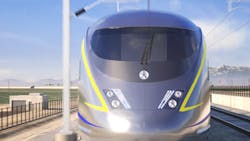CHSRA issues progress report on high-speed rail project
The California High Speed Rail Authority (CHSRA) hosted a press event on Aug. 25, where speakers expressed optimism about where the California high-speed rail project is heading.
“This is the state’s opportunity to commit to stable, long-term funding for 21st century transportation throughout the state of California,” said California Senate Transportation Chair Sen. Dave Cortese (D-CA-15). “We can’t build a 21st century transportation system on one-time money alone.”
During the event, Cortese spoke about State Bill (SB) 545, which was introduced by Cortese in February and focuses on economic development and value capture opportunities along the high-speed rail corridor. The bill directs the California Governor’s Office of Business and Economic Development to commission a study on economic opportunities along the high-speed rail corridor and other rail projects in California that are planned to directly connect to the high-speed rail project and submit a progress report by 2027, with final recommendations for the project due a year later.
“The bill creates a clear policy framework that allows high-speed rail to pay for itself over time,” Cortese said.
The bill is currently in the Assembly, having passed the Senate and cleared the Local Government Committee. Its next step to passing is to receive approval by the Assembly Appropriations Committee.
Cortese also emphasized the project is resonating with the younger generation, bringing up that a recent poll conducted by a UC Berkeley Institute of Governmental Studies, in conjunction with a POLITICO-Citrin Center-Possibility Lab poll, found that 79% of Gen Z and 72% of Millennials support continuing the project.
Chris Hannan, president of the State Building and Construction Trades Council of California, which is working on the high-speed rail project, agreed with Cortese’s remarks regarding the project making an imprint on future generations.
“This project will not only change and re-shape generations to come in a positive transformation way that very few projects have the ability to do, but it is shaping generation change today,” Hannan said. “Thousands of building trades members are working on the project today. Going through the apprenticeship readiness program with Valley Build, in partnership with our local Building Trades Council, are introducing the trades to people who could use an opportunity.”
CAHSRA CEO Ian Choudri spoke about the next steps for the project, stating, “The program is now at its crossroads. We now have to make decisions [on the project]. We can choose to let the challenges of the past define the program’s future, or we can meet the moment by supporting high-speed rail with the right tools and partners.”
The press event followed CHSRA issuing a supplement to the 2025 Project Update Report on Aug. 22. The agency notes the report to the legislature provides a clear path forward to connect the high-speed rail system to Northern and Southern California via the Central Valley by 2039. The authority says the plan is contingent on sufficient, long-term funding and will achieve commercial success at the earliest possible stage.
“I see clearer now more than ever the potential for this transformational project, one that can reshape the state and our society for the better,” Choudri noted. “I see a future—by 2038 to 2039—when operations are already connecting the Central Valley to population centers and innovation hubs, offering new career opportunities, economic mobility, affordable housing and a cleaner environment. A system that is efficient, sustainable and equitable. A system that connects us to each other and to the world around us.”
The authority notes the report puts a focus on constructing a commercially viable high-speed rail system as soon as possible with available financial resources, while making the most meaningful progress to completing full service between downtown San Francisco and downtown Los Angeles/Anaheim area to date.
The report lays out three high-speed rail business case scenarios. According to the CHSRA, these scenarios include updated cost estimates, ridership and revenue projections and funding requirements:
- Merced – Bakersfield: Complete the current statutorily required segment under design and active construction. The 171-mile high-speed rail line would enhance service in the Central Valley.
- San Francisco – Gilroy – Bakersfield: Build high-speed rail infrastructure extending from the Central Valley to Gilroy and collaborate with partners to enhance the Gilroy to San Jose rail corridor to allow for continuous service from San Francisco to Bakersfield.
- San Francisco – Gilroy – Palmdale: Build an expanded high-speed rail infrastructure from Gilroy to Palmdale that supports continuing service to San Francisco and connects with Metrolink in Palmdale, utilizing the High-Desert Corridor to connect to Brightline West service to Las Vegas and Rancho Cucamonga in Victor Valley.
According to the CHSRA, the report outlines several opportunities for the state of California to support the project, including stable, long-term funding, environmental streamlining, actions to address permitting and third-party coordination and updates to state law to provide needed construction flexibility, among others.
The report also highlights the opportunity long-term stable state funding provides in attracting private sector interest and enabling accelerated project delivery, avoiding stop-and-go delays, potentially saving time and public funding. Despite funding uncertainty, CHSRA says work still continues daily on the high-speed rail project, with 171 miles currently under design and construction from Merced to Bakersfield, Calif. Nearly 70 miles of guideway are complete, along with 55 fully completed structures; an additional 29 more structures are underway across Madera, Fresno, Kings and Tulare counties.
The plan comes as the Federal Railroad Administration (FRA) rescinded $4 billion of unspent federal funds from the CHSRA in July following FRA’s compliance review on the high-speed rail project. On Aug. 26, FRA withdrew funding for four projects related to high-speed rail:
- Le Grand Overcrossing Project on the Merced Extension ($89.6 million)
- Southern San Jose Grade Separations (Monterey Road) ($7.5 million)
- DTX Final Design for Track and Rail Systems Project ($24.7 million)
- Madera High-Speed Rail Station Project ($54.5 million)
“In 20 years, California has not been able to lay a single track of high-speed rail,” said U.S. Department of Transportation (USDOT) Sean P. Duffy. “[Former President] Joe Biden and [former USDOT Secretary] Pete Buttigieg didn’t care about these failures and dumped hundreds of millions of dollars into the state’s wish list of related fantasy projects. The waste ends here. As of today, the American people are done investing in California’s failed experiment. Instead, my department will focus on making travel great again by investing in well-managed projects that can make projects like high-speed rail a reality.”
About the Author
Brandon Lewis
Associate Editor
Brandon Lewis is a recent graduate of Kent State University with a bachelor’s degree in journalism. Lewis is a former freelance editorial assistant at Vehicle Service Pros in Endeavor Business Media’s Vehicle Repair Group. Lewis brings his knowledge of web managing, copyediting and SEO practices to Mass Transit magazine as an associate editor. He is also a co-host of the Infrastructure Technology Podcast.

